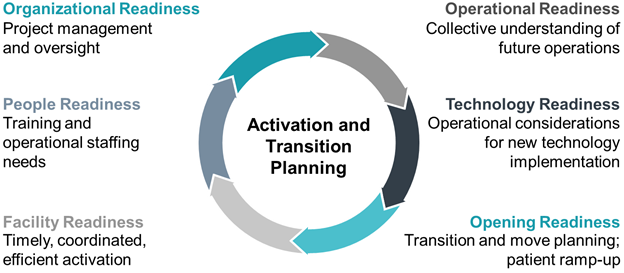In an era of infinite challenges and finite resources, health systems must employ a rigorous approach to strategic and facility planning. This is particularly true for oncology, where the pace of change and innovation is unprecedented.
Activation and transition planning is one of the most important and exciting phases of the facility development process, focused on converting design plans and a construction site into an operational environment. This phase is commonly organized into six readiness categories.
 1. Organizational Readiness
1. Organizational Readiness
An oversight planning team facilitates information exchange and acts as the decision-making authority for various work streams.
2. Operational Readiness
Operationalization involves reviewing floor plans, customizing and optimizing workflows, and building consensus on inter- and intradepartmental processes.
3. People Readiness
Clinicians and staff must be oriented to the new space and trained to deliver care in new ways. Communication with staff and the community should happen frequently.
4. Technology Readiness
New, state-of-the-art technology (e.g., MRI-guided linear accelerators, proton therapy) may require training.
5. Facility Readiness
Construction and facility handover must be thoroughly planned and aligned to minimize risk.
6. Opening Readiness
To prepare for a safe and timely opening, it is critical to focus on planning for the opening day.
This is part of an ongoing series from ECG Management Consultants about strategic considerations for health systems as they create new cancer facilities. For more information, visit ECG’s website.

